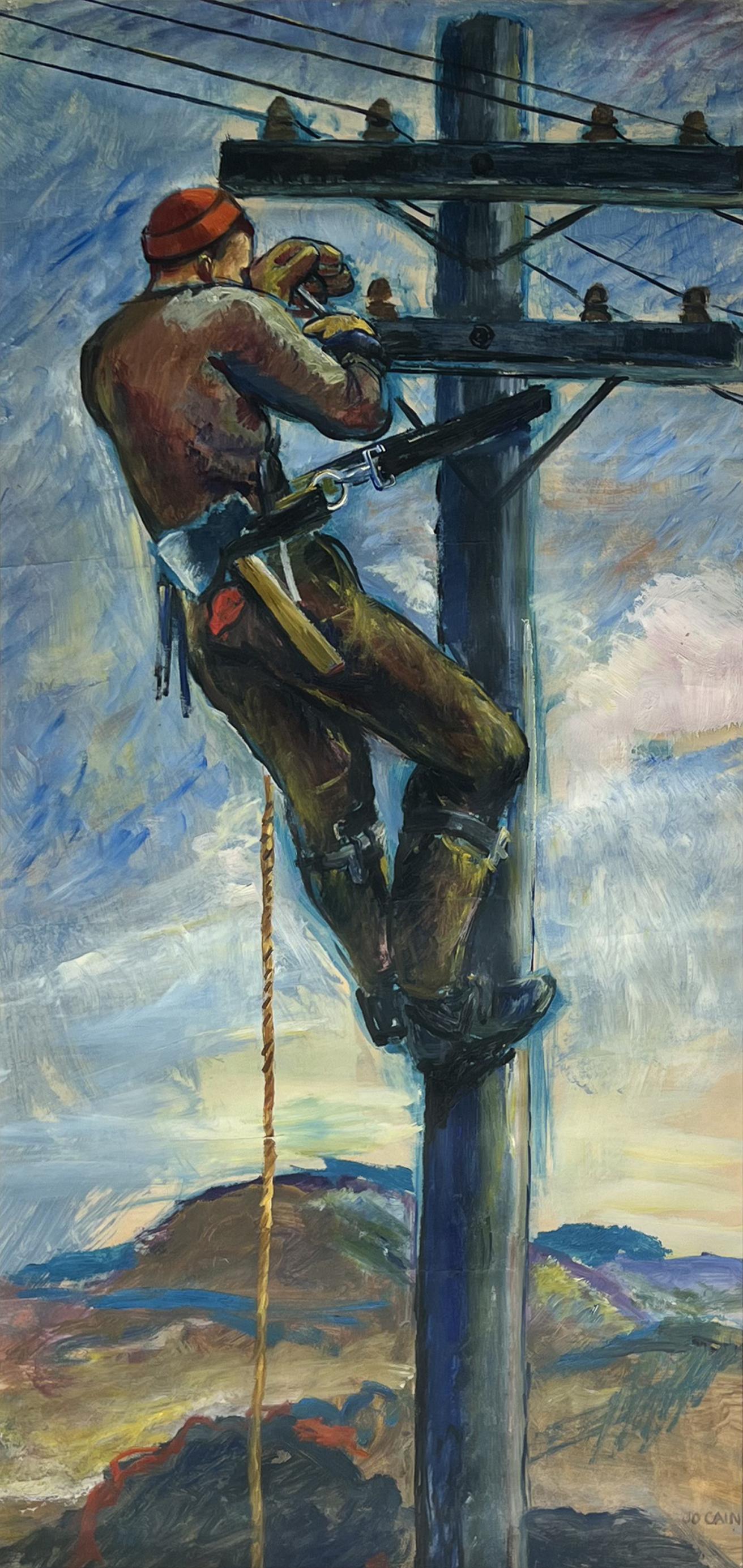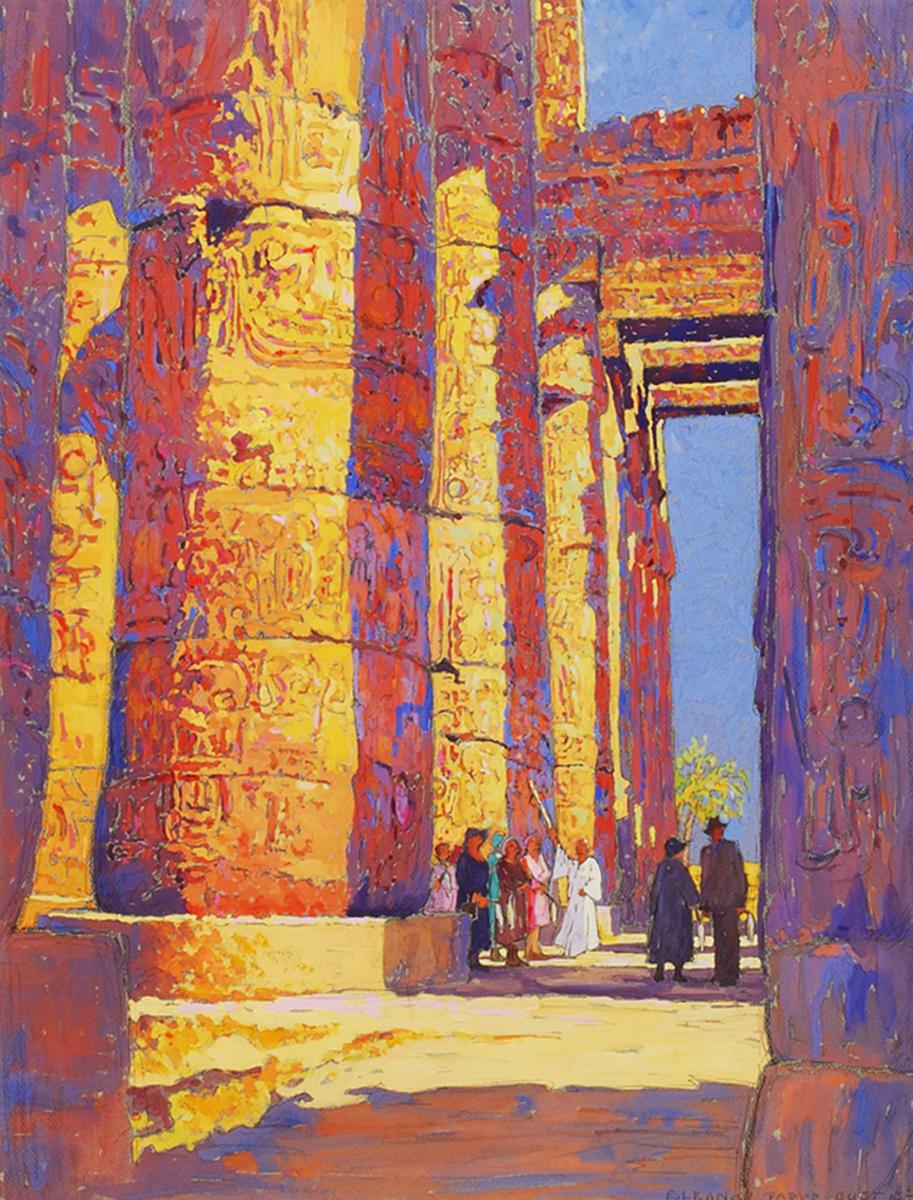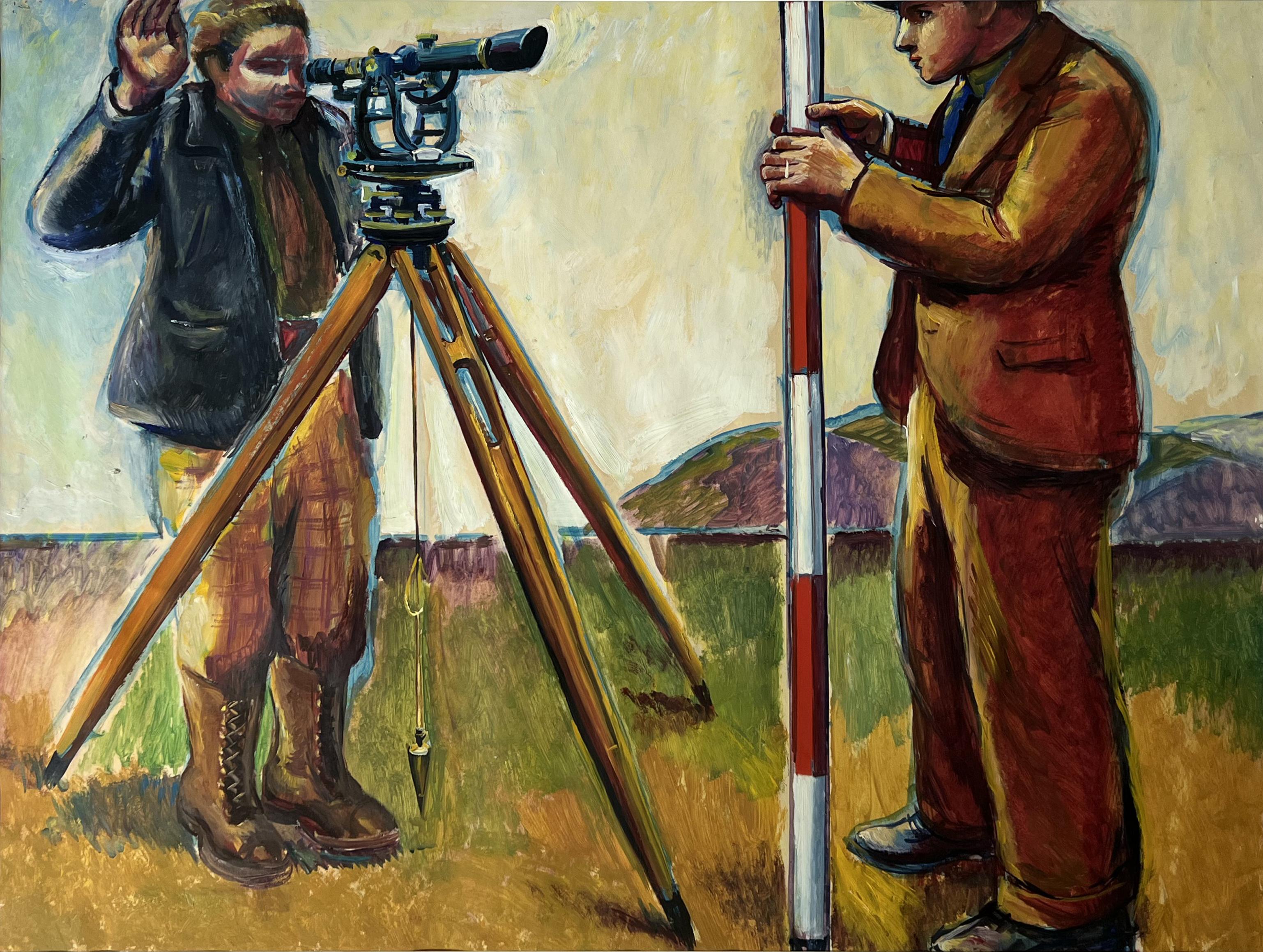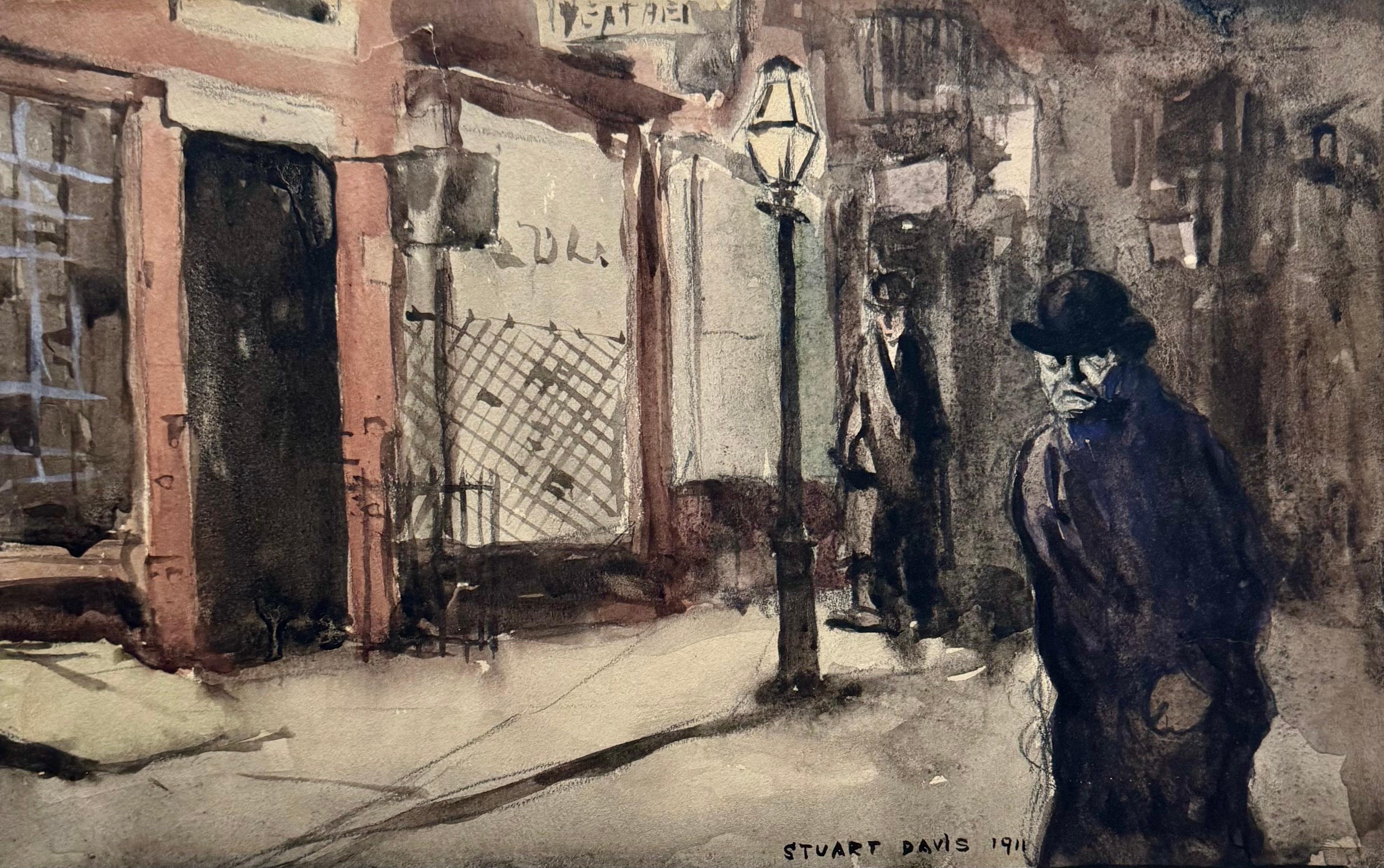Items Similar to Industrial Man Working Mid 20th Century American Scene Social Realism Modern WPA
Want more images or videos?
Request additional images or videos from the seller
1 of 7
Jo CainIndustrial Man Working Mid 20th Century American Scene Social Realism Modern WPAc. 1930s
c. 1930s
About the Item
Industrial Man Working Mid 20th Century American Scene Social Realism Modern WPA
Jo Cain (1904 - 2003)
Hammering Nails
39 x 50 ½ inches
Gouache on paper c. 1930s
Signed lower right
44 x 55 inches framed
Our gallery is pleased to present the exhibition, "Jo Cain: Echoes of an Era," a tribute to the enduring legacy of Joseph Lambert Cain and a celebration of his art that transcends time and remains relevant today. The exhibition features mural studies, works on paper and paintings from the 1930s and 40s, all are available on 1stDibs.
BIO
JOSEPH LAMBERT CAIN (1904–2003)
A painter, muralist, and art educator, Joseph Cain's work was consistently infused by the color and vibrancy of his native New Orleans, even as he pursued a career that took him far from home. Beginning at the age of sixteen, his educational journey led him first to the Art Institute of Chicago and then to the Art Students League in New York, where he was instructed by Kenneth Hayes Miller, Kimon Nicolaides and Vaclav Vytlacil. He later studied under the Abstract Expressionist Hans Hoffman. A 1929 Carnegie Fellowship funded a year's enrollment at the Sorbonne in Paris and travel throughout Europe; Cain also received multiple Tiffany Foundation Fellowships.
Using thickly applied paint, layered color planes, and multiple perspectives, Cain created paintings, including streetscapes, marine scenes, and landscapes, which were sometimes categorized as "decorative expressionism" beginning in the late 1930s.
In 1932, Cain's entry to the First Biennial Exhibition of Contemporary American Painting at the Whitney Museum of American Art hung in the exhibition's entry way; other works were shown at such prestigious venues as the Museum of Modern Art, American Art, Pennsylvania Academy of the Fine Arts, National Academy of Design, and Carnegie Institute.
He also executed a monumental mural at New York State Training School where he was employed as a teacher. While living in New York during this period, Cain was an integral member of a contemporary art collective known as "The Group," whose participants included Milton Avery, George Biddle, Robert Gwathmey, Marsden Hartley, John Marin, and many other important modernists.
Jo’s work evolved continuously. Moving from realism in the ‘20’s, he developed a highly personal, cubism based, abstract style similar in spirit to that of Stuart Davis and clearly influenced by Leger, Matisse and Picasso. In 1944, Cain joined the faculty at the University of Rhode Island, establishing and chairing the art department for over two decades. He continued creating art until his death.
- Creator:Jo Cain (1904)
- Creation Year:c. 1930s
- Dimensions:Height: 44 in (111.76 cm)Width: 32 in (81.28 cm)Depth: 2 in (5.08 cm)
- Medium:
- Movement & Style:
- Period:
- Condition:soft creases.
- Gallery Location:New York, NY
- Reference Number:1stDibs: LU1156213217372
About the Seller
5.0
Platinum Seller
These expertly vetted sellers are 1stDibs' most experienced sellers and are rated highest by our customers.
Established in 2008
1stDibs seller since 2019
164 sales on 1stDibs
Typical response time: <1 hour
- ShippingRetrieving quote...Ships From: Pawling, NY
- Return PolicyA return for this item may be initiated within 3 days of delivery.
More From This SellerView All
- Man Working Mid 20th Century American Scene Social Realism Industrial WPA ModernBy Jo CainLocated in New York, NYMan Working Mid 20th Century American Scene Social Realism Industrial WPA Modern Jo Cain (1904 - 2003) Telephone Pole Worker 38 1/4 x 18 1/2 inches Oil on pap...Category
1930s American Realist Figurative Drawings and Watercolors
MaterialsPaper, Gouache
- Surveyors WPA American Scene Mid 20th Century Modern Social Realism Men WorkingBy Jo CainLocated in New York, NYSurveyors WPA American Scene Mid 20th Century Modern Social Realism Men Working Jo Cain (1904 - 2003) Surveyors 30 ½ x 40 ¼ inches (sight) Gouache on paper c. 1930s Signed lower rig...Category
1930s American Realist Figurative Drawings and Watercolors
MaterialsGouache, Paper
- Answering the Door Early 20th Century w/c Fauvism Social Realism American SceneBy Stuart DavisLocated in New York, NYAnswering the Door Early 20th Century w/c Fauvism Social Realism American Scene Note: We have three similar in style works from 1911 available now on 1stDibs. All are framed identi...Category
1910s American Realist Figurative Drawings and Watercolors
MaterialsPaper, Watercolor
- Two Men on a Street Early 20th Century w/c Fauvism Social Realism American SceneBy Stuart DavisLocated in New York, NYTwo Men on a Street Early 20th Century w/c Fauvism Social Realism American Scene Note: We have three similar in style works from 1911 available now on 1stDibs. All are framed identi...Category
Early 1900s American Realist Figurative Drawings and Watercolors
MaterialsPaper, Watercolor
- "Backyards" Early 20th Century Watercolor Fauvism Social Realism American SceneBy Stuart DavisLocated in New York, NY"Backyards" Early 20th Century Watercolor Fauvism Social Realism American Scene Note: We have three similar in style works from 1911 available now on 1stDibs. All are framed identic...Category
1910s American Realist Figurative Drawings and Watercolors
MaterialsPaper, Watercolor
- "Going to the Festival" WPA Ashcan 20th Century American Scene Modern RealismBy Daniel Ralph CelentanoLocated in New York, NY"Going to the Festival" WPA Ashcan 20th Century American Scene Modern Realism Daniel Celentano (1902 - 1980) "Going to the Festival," 14 1/2 x 10 1/2. Watercolor on paper, c. 1930s....Category
1930s American Realist Figurative Drawings and Watercolors
MaterialsWatercolor, Paper
You May Also Like
- Tourists Viewing the Temple of Karnak, EgyptBy Eleanor Parke CustisLocated in New York, NYEleanor Park Custis painted scenes as varied as the artist's travels: from her hometown of Washington, D.C., to the coastal towns of New England; from the prosperous fishing villages of Brittany, to Venice and the mountain villages and lakes of northern Italy. While Custis's subjects are diverse, her style is consistent and distinctive throughout this body of work. Her use of flat areas of color delineated by dark contours is reminiscent of the aesthetics of woodblock printing. Like many artists of the day, she was profoundly influenced by Japanese woodblock prints, and her adaptation of the aesthetic by 1924 led to her most productive artistic period. Eleanor Custis hailed from a socially prominent Washington, D.C., family. She was distantly related to Martha Custis Washington, America's first First Lady. Custis began three years of formal art training in the autumn of 1915 at the Corcoran School of Art in Washington, and was guided and inspired by Impressionist artist Edmund C. Tarbell, one of the Ten American Painters, who became the Corcoran School's principal in 1918. Custis exhibited widely in many of the Washington art societies and clubs for much of her career. She was also a frequent exhibitor at the Grand Central Art Galleries in New York City; her last one-woman show there was in April 1945. Custis's mature style emerged in scenes of the streets, wharves, and drydocks of seacoast villages from Maine to Massachusetts, which she visited during the summers of 1924 and 1925. She was working in Gloucester, Massachusetts in August 1924, and painted several gouaches of the town's wharves and winding streets, including In Gloucester Harbor and At the Drydock, Gloucester. During her stay, Custis may have met Jane Peterson or at least must have seen her work, the best of which was executed in Gloucester during the preceding ten years. The similarity between their styles is unmistakable, but, while it may be tempting to suggest that Custis was influenced by Peterson during her summer in Gloucester, the connection between their work is probably more a case of shared aesthetics and common European influences. Custis expanded her subject repertoire with three trips to Europe between 1926 and 1929, and was inspired by the Old World charm of Holland, northern France, Switzerland, and Italy, leading to such works as New Kirk, Delft, Holland, Market Day in Quimper, At the Foot of the Matterhorn, and The Town Square, Varenna. A Mediterranean cruise in 1934 introduced her to the Near East, and the bustling, colorful streets and bazaars of Cairo, captured in works like A Street in Cairo, Egypt and A Moroccan Jug...Category
20th Century American Realist Landscape Drawings and Watercolors
MaterialsPaper, Gouache
- Environmental Prognostication Coil Narrative "Homo Sapiens R.I.P."Located in Miami, FL"They paved paradise and put up a parking lot," Joni Mitchell said. - - Created in 1969, at the dawn of the American environmental movement, artist Richard Erdoes draws a sequential narrative in the form of a coil. From inception to destruction, it illustrates a list of things that humans are doing to destroy the world we live in. The work was commissioned for school-age humans and executed in a whimsically comic way. Yet the underlying narrative is sophisticated and foreshadows a world that could be on the brink of ecological disaster. Graphically and conceptually, this work exhibits an endless amount of creativity and Erdoes cartoony style is one to fall in love with. Signed lower right. Unframed 12.4 inches Width: 12.85 inches Height is the live area. Board is 16x22 inches. Richard Erdoes (Hungarian Erdős, German Erdös; July 7, 1912 – July 16, 2008) was an American artist, photographer, illustrator and author. Early life Erdoes was born in Frankfurt,to Maria Josefa Schrom on July 7, 1912. His father, Richárd Erdős Sr., was a Jewish Hungarian opera singer who had died a few weeks earlier in Budapest on June 9, 1912.After his birth, his mother lived with her sister, the Viennese actress Leopoldine ("Poldi") Sangora,He described himself as "equal parts Austrian, Hungarian and German, as well as equal parts Catholic, Protestant and Jew..."[4] Career He was a student at the Berlin Academy of Art in 1933, when Adolf Hitler came to power. He was involved in a small underground paper where he published anti-Hitler political cartoons which attracted the attention of the Nazi regime. He fled Germany with a price on his head. Back in Vienna, he continued his training at the Kunstgewerbeschule, now the University of Applied Arts, Vienna.[5] He also wrote and illustrated children's books and worked as a caricaturist for Tag and Stunde, anti-Nazi newspapers. After the Anschluss of Austria in 1938 he fled again, first to Paris, where he studied at the Academie de la Grande Chaumiere, and then London, England before journeying to the United States. He married his first wife, fellow artist Elsie Schulhof (d. xxxx) in London, shortly before their arrival in New York City. In New York City, Erdoes enjoyed a long career as a commercial artist, and was known for his highly detailed, whimsical drawings. He created illustrations for such magazines as Stage, Fortune, Pageant, Gourmet, Harper's Bazaar, Sports Illustrated, The New York Times, Time, National Geographic and Life Magazine, where he met his second wife, Jean Sternbergh (d. 1995) who was an art director there. The couple married in 1951 and had three children.[6] Erdoes also illustrated many children's books. An assignment for Life in 1967 took Erdoes to the Pine Ridge Indian Reservation for the first time, and marked the beginning of the work for which he would be best known. Erdoes was fascinated by Native American culture, outraged at the conditions on the reservation and deeply moved by the Civil Rights Movement that was raging at the time. He wrote histories, collections of Native American stories...Category
1960s American Realist Landscape Drawings and Watercolors
MaterialsInk, Gouache, Illustration Board
- "Sleigh Ride, Winter, " Fletcher Martin, Woodstock, Holiday Scene IllustrationBy Fletcher MartinLocated in New York, NYFletcher Martin (1904 - 1979) Sleigh Ride, Woodstock, New York circa 1955 Watercolor on paper 14 x 11 inches Signed lower right Provenance: James Cox Galler...Category
1950s American Realist Landscape Drawings and Watercolors
MaterialsPaper, Watercolor
- King Street, Troy (Modern Realist Cityscape in Black & White Watercolor)By Scott Nelson FosterLocated in Hudson, NYwatercolor on paper 9 x 11 inches 17 x 21 x 1 inches, brown wood artist made frame, white mat This photo-realist cityscape of Albany, NY was painted with black and white watercolo...Category
2010s American Realist Landscape Drawings and Watercolors
MaterialsArchival Paper, Watercolor
- Mid-Century Hillside Trees Landscape Watercolor (unfinished)By Joseph YeagerLocated in Soquel, CABeautiful mid-century landscape watercolor with a tall, stately tree in the foreground, its many forking branches depicted with exceptional detail, and a verdant background of rollin...Category
Mid-20th Century American Realist Landscape Drawings and Watercolors
MaterialsPaper, Watercolor
- Mid Century Mazatlan Beach Catamaran Figurative Landscape WatercolorBy William A. CorbettLocated in Soquel, CAVibrant figurative seascape of a beach in Mazatlan, Mexico with several figures and a catamaran reflecting beautifully in the shallow water by William A. Corbett (American. 1914-1960). Titled "Beach- Mazatlan" on verso. Signed "William Corbett" in lower left corner. Presented in a simple wood frame, with a double mat of off-white silk and royal blue with plexiglass. Image size: 22”H x 14.75”L William A. Corbett began drawing at an early age. He constructed signs and displays for theaters and nightclubs around Pittsburg. He studied art with Vincent Nesbert at the Pittsburg Art Institute and with Robert Gwathmoy, Roy Hilton, and Robert Laper at the Carnegie Institute of Technology. He also studied painting and sculpture at the Louisville Art Center. Corbett was in the Army Engineers at Fort Knox, Kentucky where he studied, practiced, and had exhibits with army artists there from 1941-1943. He was very much interested in materials and technique, content and style in painting. His favorite Artists were El Greco, Leonardo, Rembrandt, Renoir, Burchfield, and Andrew Wyeth, Jr. He studied two years at Boston museum School with Karl Zerbe, Daivid Aronson and others. He later designed and did art work for General Outdoor Advertising Co. In 1943, he married Ruth Osborne of Louisville and they had one son, Michael. In 1951 he moved to Fort Lauderdale, Florida with his family. Exhibitions: Army Art Show--- 1st Prize in Landscape, 1942 Kentucky & southern Indiana Exhibition-- Honorable mentions for Fisherman's Curse 1949, Don Q...Category
1960s American Realist Landscape Drawings and Watercolors
MaterialsPaper, Watercolor
Recently Viewed
View AllMore Ways To Browse
Iles De Lerins
Emil Weiss
Ladies Dance Shoes
19th Century Pencil Drawing
Pen And Ink Fashion Drawings
Night Scene Oil Painting
Spectrum Acrylic
Italian Side Able
Clarke Clarke
Architectural Book Ends
Photographs By Man Ray
Jewish Start
Prince Clothes
Robert Stanley Print
Review Link
Hunt Slonem Framed Signed
Black And White Abstract Sketch
Vasarely Signed Prints





